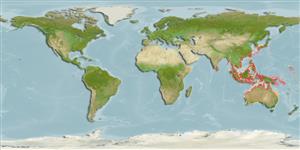Common names from other countries
Classification / Names / Names
Namen | Synonyme | Catalog of Fishes (gen., sp.) | ITIS | CoL | WoRMS
Environment: milieu / climate zone / depth range / distribution range
Ökologie
; tiefenbereich 0 - 25 m (Ref. 348). Tropical
Indo-West Pacific: from East Africa to the Philippines; north to Japan and south to Indonesia.
Length at first maturity / Size / Gewicht / Alter
Maturity: Lm ? range ? - ? cm Max length : 8.0 cm TL Männchen/unbestimmt; (Ref. 348); common length : 6.0 cm TL Männchen/unbestimmt; (Ref. 348)
Shell rather inflated, roughly triangular and elongate-ovate in outline. Anterior margin short, slightly protruding anteriorly beyond the umbones. Posterodorsal margin straightish, forming a rather sharp angle with the produced, roundly wedge-shaped posterior margin. Ventral margin long and nearly straight in the posterior 2/3, recurved anteriorly. Outer surface smoothish, with only fine concentric growth marks, frequently eroded towards the umbones. Periostracum hairs not branched, developed on posterior half of the of valves. Hinge line smooth, without teeth or crenulations. Anterior adductor scar present. Internal margins smooth. Colour: outside of shell dull olive-brown, often with a median yellowish radial band. Interior pearly, pale greyish blue to purple.
Attached to pebbles or to mangrove prop roots, on muddy bottoms of sheltered bays, especially in areas under the influence of freshwater supply. Littoral and sublittoral to a depth of 25 m (Ref. 348).
Life cycle and mating behavior
Geschlechtsreife | Fortpflanzung | Ablaichen | Eier | Fecundity | Larven
Members of the class Bivalvia are mostly gonochoric, some are protandric hermaphrodites. Life cycle: Embryos develop into free-swimming trocophore larvae, succeeded by the bivalve veliger, resembling a miniature clam.
Poutiers, J.M. 1998. (Ref. 348)
IUCN Rote Liste Status (Ref. 130435)
CITES Status (Ref. 108899)
Not Evaluated
Not Evaluated
Nutzung durch Menschen
Fischereien: kommerziell
| FishSource |
Tools
Internet Quellen
Estimates based on models
Preferred temperature
(Ref.
115969): 24.7 - 29.3, mean 28.7 (based on 1901 cells).
Verwundbarkeit
Low vulnerability (10 of 100).
